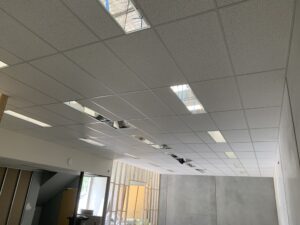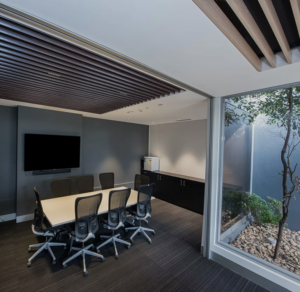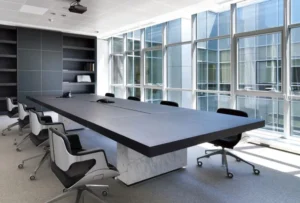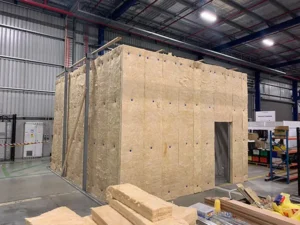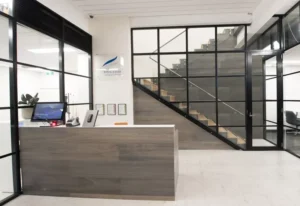Ergonomic Office Set Up
Ergonomics has long been a term thrown around to focus on employee well being and productivity. Let’s break it down to understand it better. Ergonomics is considered a science of design that caters best to humans. It can apply to office spaces, transport, furniture and various tools and equipment.
A modern office environment is pretty much incomplete without incorporating ergonomics into its design. In Australia, where workplace health and safety is key, implementing ergonomic principles tailored to your office needs is an essential part of any office fit out.
In this article, we’ll focus more on what ergonomics in the workplace entails and how you can include it in your office design project. From office workstation layouts to choosing the right lighting, we will discuss creative strategies to achieve an ergonomic office space that both improves employee morale and reduces the risk of work-related injuries.
Once you’re done reading, consider taking a look at our Melbourne office fit out services, all of which are based on office ergonomics as a foundation.
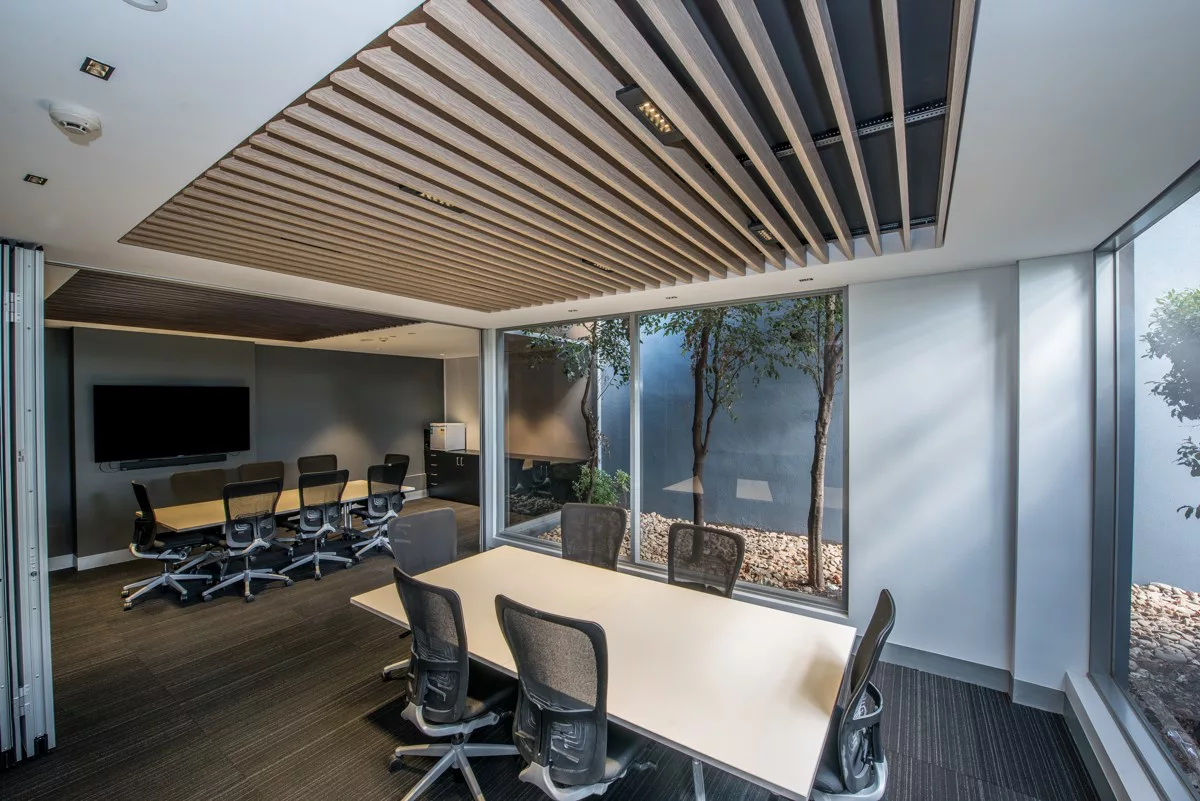
What is an Ergonomic Office?
A contemporary office space focuses on comfort and inclusivity for a range of employees and their unique needs. Different elements of the office are optimised to reduce any physical and mental strain on the staff. Considering your employees have to spend a major chunk of their day at the office, often seated or taking up repetitive tasks, it can help to understand below ergonomic requirements of the workplace:
- Ergonomic Workstations & Furniture: This includes adjustable chairs, office desks and accessories that support correct posture and reduce the risk of sprains, strains and other injuries.
- Office Workstation Layout: Arrangement of workstations to allow easy access to equipment and resources. This also includes spaced out and open layouts to improve ventilation.
- Ergonomic Lighting: Adequate lighting that creates a comfortable visual environment for staff. This could mean lighting that reduces glare and eye strain.
- Employee Training & Activities: Education and training on ergonomic practices to enable employees to make the best use of ergonomic office elements and maintain healthy work habits. This could include scheduled breaks or team activities to allow time away from desks.
Benefits of Ergonomics in the Workplace
Think of ergonomically designed tools, spaces and vehicles that fit the way humans work as the new norm, instead of the other way around. Keeping ergonomics in mind can offer a range of benefits in the workplace:
- Improved Productivity: An ergonomically optimised office can boost workflow and reduce task errors. Organisational processes and workstations that are centred around employee ease and capabilities may help bring about better performance.
- Employer Reputation: A company that prioritises workforce comfort, health and safety through ergonomically set up workspaces may be more attractive for prospective employees and help to retain top company talent.
- Reduced Risk of Injury: Even an office environment is prone to staff injuries that can quickly mount up healthcare costs for employers. In fact, most work-place injuries reported in Australia were related to sprains, strains and chronic joint or muscle conditions [2021-2022]. By incorporating ergonomics, the risk of these injuries could be reduced, especially those arising from repetitive movements and poor posture.
- Health, Safety & Legal Compliance: Operating a business in Australia means complying with a range of workplace health and safety rules and policies. While most of Australia follows model WHS laws, you’ll find an extensive regulation list for Victoria, which follows regulations highlighted by WorkSafe Victoria [e.g. Occupational Health & Safety Act]. Incorporating office ergonomics makes you more compliant to these policies and reduces legal risks.
Ergonomic Hazards
We discussed a key benefit of ergonomics was to control work-related injuries, which can be caused by ‘ergonomic hazards’. These are risks in the workplace that could lead to musculoskeletal injuries and other ergonomic-related health issues. By incorporating employee focused office layouts, you can steer clear of common ergonomic hazards such as
- Awkward and Incorrect Posture [e.g. hunching forward]
- Repetitive Motions [e.g. typing or operating machinery]
- Forceful Exertions [poorly lifting, pushing, pulling or carrying heavy objects]
- Prolonged Vibrations [from tools and machinery]
- Inflexible Workstations [e.g. non adjustable chairs, desks, lighting]
Timely identifying and fixing ergonomic hazards in the workplace is essential for employee health and well-being. Keep reading to learn possible ergonomic interventions that can create a safer work environment for your employees.
Ergonomic Essentials for the Office
Now that you know what benefits an ergonomic workplace entails, you may want to know what aspects you can work on for your office to meet important ergonomic requirements. It goes without saying that your office interior design needs to be able to cater to a diverse type of workforce. This can include people of all shapes and sizes, disabilities and illnesses.
1. Ergonomic Workstations
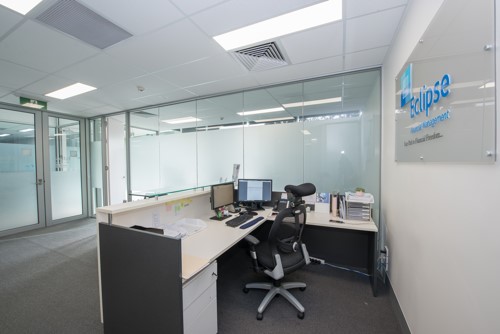
Workstations are dedicated areas for individual employees to complete their day to day work tasks. They often come equipped with necessary furniture and equipment such as a desk, chair, storage cabinet, computer, keyboard etc.
Workstations are possibly the most important part of any ergonomic office project and can directly impact employee health, productivity and comfort levels. Since employees spend the most time here, workstations and joineries need to fit around the employee’s distinct requirements.
Here’s how a workstation can be set up with ergonomics in mind:
Adjustable Desk
It can help to set up adjustable-height desks that are comfortable to use for taller and shorter than average employees. This can prevent slouching for taller staff, and wrist and elbow strain for those who are shorter. A good way to evaluate desk height is to ensure that the user’s arms are parallel to the floor, or their elbows are bent at 90 degrees or more.
Adjustable desks also means having the option of standing desks. This could either be a separate section of the workplace, or built into individual workstations to prevent employees sitting for long hours.
Ergonomic Chairs
Chairs that support the spine, arms and thighs are important for a desk-based office job. Additionally, having height adjustable chairs can also help employees be in line with their office desks to avoid slouching.
Ergonomic office seating for your employees will have good lumbar support and be comfortable for their lower back. Their thighs will be near-parallel to the floor, knees will be slightly below their hip level and be a few centimetres ahead of the cushion edge. Feet are ideally laid flat on the floor, but foot rests could also be used where necessary for individual needs.
Computer & Other Equipment
The keyboard, monitor and mouse all play a part in an ergonomic office workstation:
- The top of the monitor needs to be at eye level, which can be achieved through an adjustable monitor height, adjustable desks or adjustable chairs. Depending on the size, larger monitors need to be at a greater distance from employees to avoid eye straining.
- For the keyboard, it should not be placed too high or too low to cause wrist and arm strain [think 90 degree angle for arms], and be as close to the front edge of the desk as possible.
- Using an ergonomic mouse that correctly fits most employee hand sizes can help avoid repetitive movement strains. Plus, it should be kept close to the keyboard to avoid awkward overreaching.
In addition, if your office desks also include other equipment such as printers, fax machines, scanners or filing cabinets, it is important to have them at a reachable length so employees don’t have to bend at awkward angles and be at greater risk of musculoskeletal disorders.
2. Ergonomic Layout
An ergonomic layout is more than just office workstations. It is about how office rooms, furniture and equipment are placed in an office space. With small office fit outs, focusing on ergonomic layouts may be even more important to give the feeling of a larger, more breathable space.
For an improved office design, consider a mix of closed and open office layout that has workstations more spaced out. On top of improving air circulation and temperature, this setup can give privacy to and reduce distractions for employees.
Additional layout changes can include standing areas where employees can work without sitting, or meeting rooms and breakouts that have varied seating options to give employees a break from their everyday office desk. Building quiet areas using office soundproofing solutions for employees to brainstorm in or take short breaks in may also help with their stress and productivity levels.
3. Ergonomic Lighting
Lighting plays an essential part in an ergonomic office environment. Ideal office lighting will not only brighten up the office, but also reduce eye strain and glare.
Fixed and uniform lighting across the entire office may not be the best option in line with ergonomic principles. Instead, consider an office space that takes into account lighting needs of each section separately. For more detail-oriented work, bright uniform lighting may be useful, while for areas of brainstorming, collaboration or unwinding, softer lights may boost productivity. It can also help to add adjustable lighting to workstations so employees can change up light intensity and position as per their unique needs.
Don’t forget the importance of natural light in an office setting. Where possible, natural light should be considered over artificial fluorescent lights. Not only are they more aesthetically pleasing, but can be a great mood and energy lifter for your employees. Plus, adding glass partitions can further help spread natural light across the office.
Of course, while working on office lighting principles, it is important to avoid placing lighting against or with computer monitors to reduce eye straining and awkward head tilts. One way to fix this issue is to also add the option of blinds for windows that can be tweaked to match the lighting needs of the workspace.
4. Other Ergonomic Practices
We’ve discussed how an office space can be best set up to meet ergonomic requirements. One last crucial element of ergonomics is to work on your organisational culture as well. This means emphasising breaks and encouraging periods of movement and activity throughout the work day to minimise ergonomic injuries in the workplace.
Conducting regular training and providing educational resources on ergonomics to staff may help achieve this. You can further facilitate employees by incorporating recreational rooms in your office space, such as cafeterias, gyms and game rooms.
Tick Off Your Ergonomic Office Requirements
Now that you’re aware of how ergonomics plays a part in the workplace, and what elements you can work on to make your office more ergonomic, it’s time to start checking off these ergonomic requirements.
If you’re seeking to optimise your workspace, make sure to reach out to fit-out experts in Melbourne. With professionals evaluating your office using a detailed office ergonomics checklist and providing fit-out solutions that work best for your office, you can expect a tailored office layout achieved with minimal downtime and disturbance.

